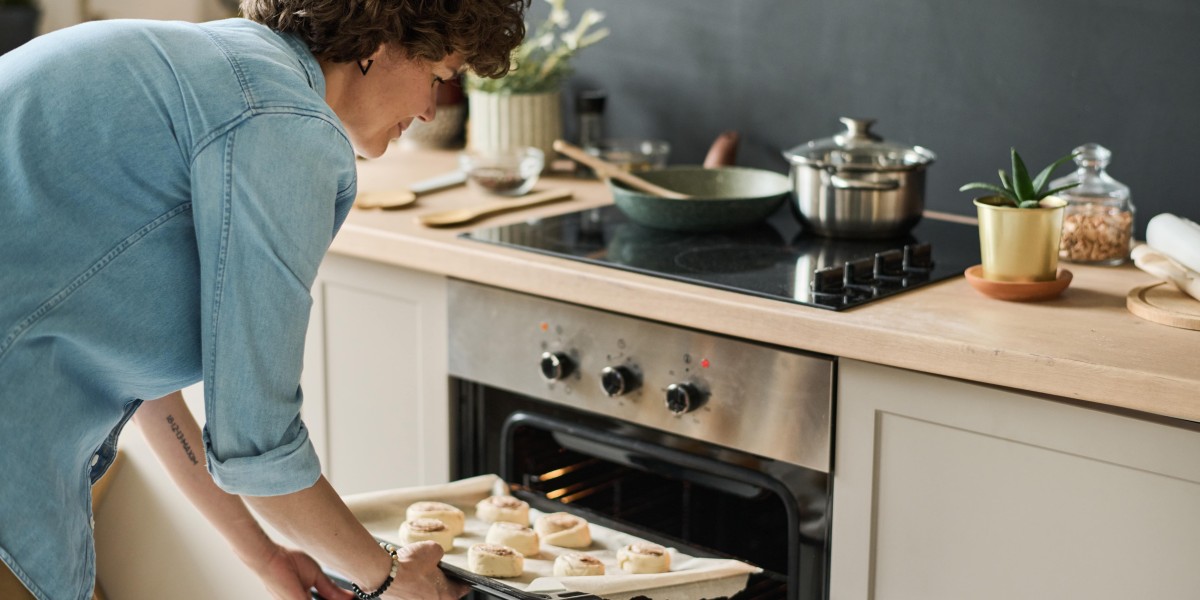The hob is at the heart of any kitchen, whether you are boiling a kettle or roasting a chicken. There are many different designs and sizes to choose from and different hob styles that include electric, ceramic and domino.
 Electric hobs have smooth surfaces and are easy to clean, but they take some time to warm up or cool down. They can only be used with flat-bottomed pans, and may include heat indicators.
Electric hobs have smooth surfaces and are easy to clean, but they take some time to warm up or cool down. They can only be used with flat-bottomed pans, and may include heat indicators.Ceramic Hobs
Ceramic hobs have revolutionised the way we cook, presenting a sleek and stylish aesthetic while remaining simple to use. They function by using heating elements under the glass surface, which is tempered, to disperse heat efficiently and evenly across your cookware. Ceramic hobs can be found in a variety of styles from traditional gas burners to more modern electric zones, with the majority featuring a black-glazed finish that is hard-wearing and durable against scratches and chips.
They have smooth, flat surfaces that are easy to clean. You can use any standard kitchen cleaner. They don't feature open flames so are a safer option for those with family members or elderly relatives in the house. They usually come with rotary or touch controls for safety, as well as an indicator of residual temperature that alerts you if an area remains hot even after removing the pan from the hob.
They are more expensive than a basic electric hob however, they are less expensive than an induction model. They can be a great option for those that do not have gas on their home. Similar to induction models are more efficient when you use cookware with flat bottoms that increase the surface area of contact with elements. The heating system won't recognize pots and pans if they are not the exact same dimensions as the element.
It is crucial to have a qualified electrician install your ceramic hob because working with electricity can be potentially dangerous if it's not done properly. If you do not have your ceramic stove installed by a professional could invalidate the warranty, and create fire hazards in the future. It's a small price to pay for peace of mind and ensuring that your new cooktop is safe to use.
Gas Hobs
Gas hobs or gas cooktops are powered by liquefied petroleum gaz (LPG). They are usually built into kitchen units or countertops. The burners can be lit manually with matches or lighters. They are controlled by knobs to adjust the heat during cooking. The main advantage of gas hobs is that they give instant heat when compared to electric models and can be used for all kinds of cooking, from simmering and boiling to frying or sauteing.
The downsides of gas hobs is that they require a gas supply and ventilation system to function, making them more expensive to set up than electric ones and they aren't as energy-efficient as induction hobs. Hobs made of gas are also a safety hazard as they use gas that is flammable and require regular maintenance to look for leaks.
Another option that is popular is an induction stove that employs electromagnetic technology to instantly heat your pans which allows them to boil water much faster than gas models and offering precise temperature control. However, induction hobs can only work with induction-compatible pans and can be a bit more expensive than some other hobs.
Another option is a ceramic-glass hob. It is sleek and is easy to clean. It's available on both induction and electric models, and is the best choice for those who prefer a sleek, modern finish to their kitchen. It's important to note that this type can get very hot and takes longer to cool and heat than gas or electric models.
A freestanding gas stove or hob is a traditional choice that's suitable for kitchens that are larger and open-plan layouts, where it can act as the focal point. It requires a designated space and is installed by professionals. Gas connections are a risk if they're not handled correctly.
Hobs Induction
A popular choice for those looking for an elegant and efficient method to cook, induction hobs utilize electromagnetic induction technology to warm pans. The glass surface is covered with coils that when a pot that is compatible is placed on them, create a magnetic field which creates an electric current to flow through its base. This creates heat that quickly warms up the food in the pan while the cooktop remains cool.
Induction hobs are also known for being more energy-efficient than conventional models, whether they are electric or gas. They only heat the space where the pan is located, which reduces waste and energy costs. Induction hobs are often equipped with a safety feature which shuts off the hob when no pan is found or if the pan is removed, thereby reducing the amount of waste.
Like gas hobs, induction models are equipped with a variety of control options that include slide, dial and touchscreen controls. A slider control is similar to the knob on a traditional cooker and lets you adjust the power level with one simple motion. Dial controls are similar to standard knobs and come with a large dial that can be turned to select the desired setting. Touchscreen hobs, usually found on more expensive induction models, with more advanced features, are an alternative option. These have a clear digital display which makes it easy to read and alter settings.
Induction hobs come with extractors integrated which work with the hood to clear steam and smoke from the kitchen and keep out mould and condensation. They can be operated separately from the rest and are typically activated through the use of a sensor or a button. They can also be set up to automatically turn on when an oven is placed over a cooking zone.
Induction hobs are limited due to the requirement for special cookware in order to work. It is required for the bottom of the pan to have a magnetic base in order to generate the electromagnetic process. However it is not certain to work on all models. Cast iron, stainless-steel that has magnetized bases and certain nonstick pans may be used with induction cooktops. However, you should always consult the manufacturer to confirm that the pan you are using is compatible before buying the model.
Domino Hobs
Domino hobs are perfect for those with a small kitchen, but want the flexibility to experiment with various cooking styles. With two zone gas, ceramic and induction domino hobs, and even the option of a griddle from Siemens, you can mix and mix to create a modular cooking area that is suited to your needs.
Solid plate hobs are the simplest kind of hobs. They use sealed plates made of metal to heat electrical elements, which in turn warm your cookware. These are inexpensive, easy to use and hard-wearing. They may take a while to cool down and heat and are more costly to run than other kinds of hobs.
The halogen model is a popular alternative to solid-plate hobs. It utilizes a row of with halogen lamps that sit on the glass ceramic surface to generate heat. The bulbs quickly glow and transfer heat directly to the pan once activated, making this type of hob an easy and flexible option. However, halogen hobs may be prone to damage due to scraping against the hard-wearing surface as well as being less energy efficient than other hobs.
Induction hobs are a new and becoming increasingly popular type of stove, employing electromagnetic technology to heat the cooking areas rather than the surface. They are more affordable and green than other hob types However, they can be more expensive than gas and require specific cookware that is compatible with induction.
Ceramic hobs are another stylish and modern option with their flat-style design seamlessly blending into the worktop to add an airy feel to your kitchen. The surface is easy to clean and does not require any special cleaning products. Some models have a stylish frameless look and can be customized with dials or touch controls, depending on your preferences.
When you are buying a new stove, make sure you look for features like overheat protection. This will shut off the heating element when it exceeds a dangerous temperature. Check for residual heat indicators which will warn you of the presence of a hot hob. A pause feature allows you to temporarily turn off all active cooking zones and can be useful if you need to leave the kitchen for a time.









